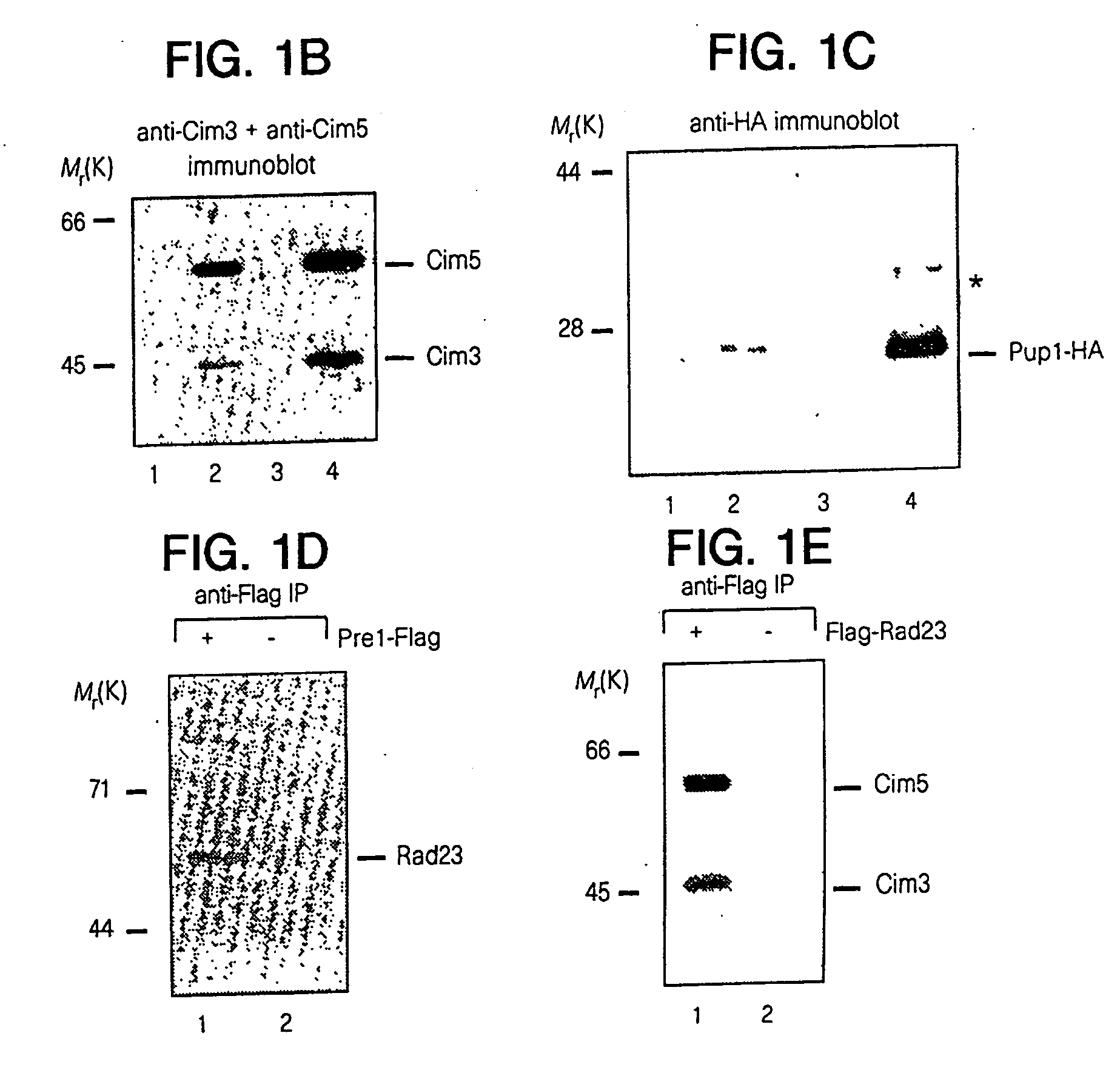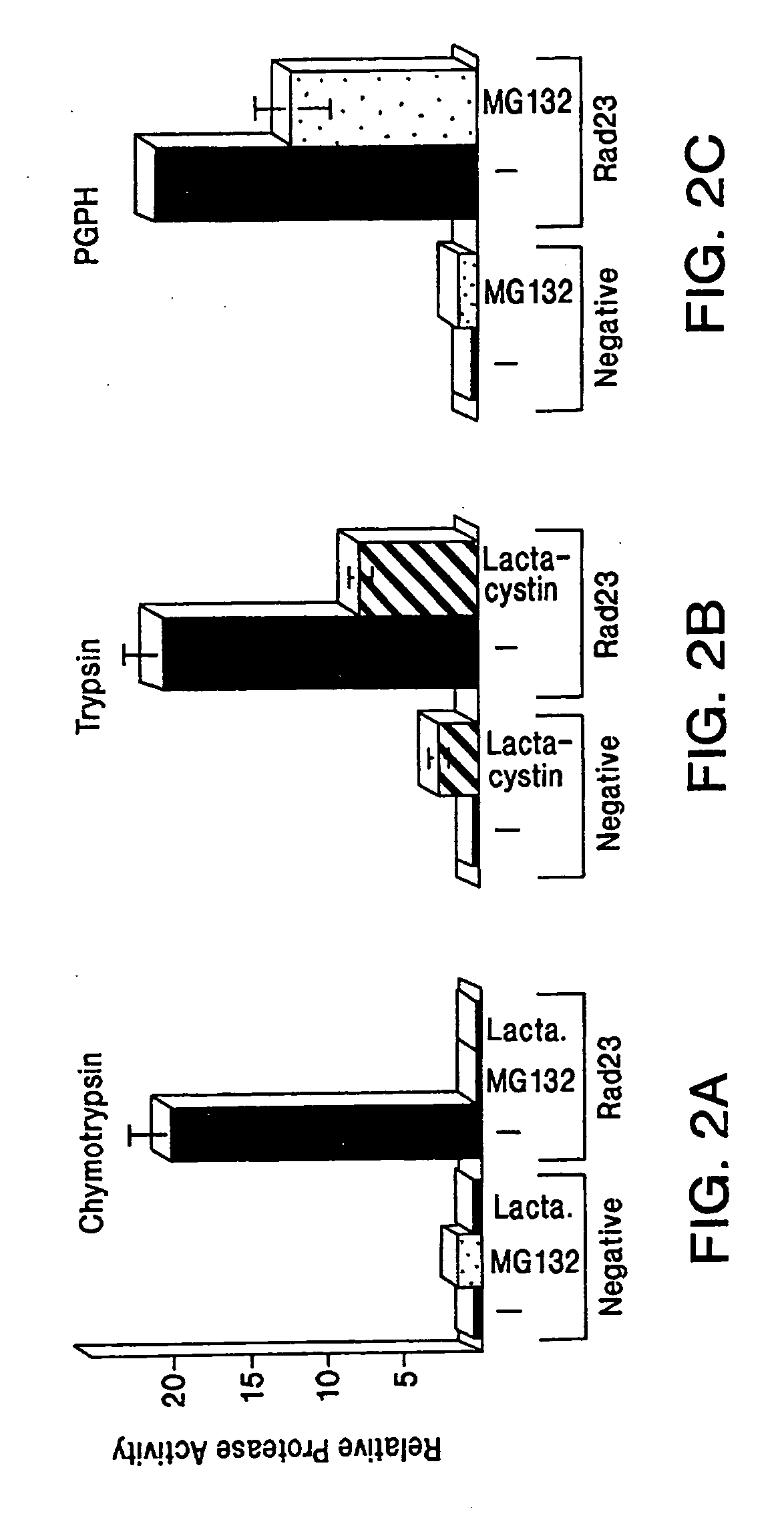Methods and compositions for rapid purification of proteasomes and methods of use of components thereof
a proteasome and purification method technology, applied in the field of methods and compositions for rapid purification of proteasomes and methods of use of components thereof, can solve the problems of inefficient, time-consuming, and inability to accurately characterize the biochemical function of rad23p in dna repair, and achieves rapid and efficient methods, facilitates molecular characterization of proteasomes, and high affinity for proteasomes.
- Summary
- Abstract
- Description
- Claims
- Application Information
AI Technical Summary
Benefits of technology
Problems solved by technology
Method used
Image
Examples
example 1
Rapid and Efficient Purification of Proteasomes Using Rad23 and Components thereof
[0058] Rad23 has an unusual N-terminal domain that bears a striking resemblance to ubiquitin (Watkins, et al. (1993) supra). This domain, which has been designated UbLR23, is important for DNA repair because its elimination causes sensitivity to UV light (Watkins, et al. (1993) supra). A role for Rad23 in the ubiquitin system has been suggested by its suppression of N-end rule induced toxicity, which raised the possibility of a proteolytic function in DNA repair.
[0059] Rad23 and Rad4, as well as the human counterparts HHR23-B and XPC, form stable interactions. It was therefore tested whether GST-Rad23 interacts with components of the DNA repair and proteolytic pathways. Rad4 was linked to the HA epitope (Tyr-Pro-Tyr-Asp-Val-Pro-Asp-Tyr-Ala; SEQ ID NO:14 (Rad4-HA)) and was found to complement rad4Δ. GST-Rad23 and Rad4-HA were expressed simultaneously in yeast cells and metabolically labeled with [35S]...
example 2
Rad23 and its Role in Protein Degradation
[0068] Nucleotide excision repair is enhanced by Rad23, a member of a class of proteins that bear unusual ubiquitin-like domains at their N-termini. Specific modifications of Rad23 cause rapid degradation via the ubiquitin / proteasome system. Unexpectedly, the short in vivo half-life of these variants does not affect the DNA damage response and can be reconciled with a growth-stage-specific function for Rad23. The degradation signal in Rad23 resides in its N-terminal ubiquitin-like domain (UbLR23), which confers instability when placed on a heterologous protein. Evidence for a proteolytic function for Rad23 is indicated by its interaction with Irt1p, a protein that bears a striking resemblance to members of the ATPase subunits of the 26S proteasome. Rad23 can be co-precipitated with immunopurified 26S proteasome, implicating a proteolytic function during DNA repair.
[0069] Isolation of High-copy Suppressors of N-end Rule Overexpression. Yeast...
example 3
Ubiquitin-Like Sequences are Proteasome Interacting Domains
[0092] A family of proteins that contain ubiquitin-like sequences (UbL's) has been identified in diverse organisms (Garrett, et al. (1995) Proc. Natl. Acad. Sci. USA 92:7172-7176; Shen, et al. (1996) Genomics 36:271-279). Some UbL's are post-translationally conjugated to other proteins in a mechanism similar to that described for ubiquitin-conjugation (Johnson, et al. (1997) J.Biol. Chem. 272:26799-26802; Mahajan, et al. (1997) Cell 88:97-107). However, a distinct class of UbL's are retained in the original translational product and not conjugated to other proteins (Watkins, et al. (1993) supra). The proteins to which these UbL's are fused share little in common and offer no obvious clues to their biological functions. Furthermore, the effect of an UbL on the activities of the protein to which it is linked is unknown. Although UbL's display no more than 20-30% identity to the amino acid sequence of ubiquitin, there are cons...
PUM
| Property | Measurement | Unit |
|---|---|---|
| temperature | aaaaa | aaaaa |
| stability | aaaaa | aaaaa |
| thermostable | aaaaa | aaaaa |
Abstract
Description
Claims
Application Information
 Login to View More
Login to View More - R&D
- Intellectual Property
- Life Sciences
- Materials
- Tech Scout
- Unparalleled Data Quality
- Higher Quality Content
- 60% Fewer Hallucinations
Browse by: Latest US Patents, China's latest patents, Technical Efficacy Thesaurus, Application Domain, Technology Topic, Popular Technical Reports.
© 2025 PatSnap. All rights reserved.Legal|Privacy policy|Modern Slavery Act Transparency Statement|Sitemap|About US| Contact US: help@patsnap.com



